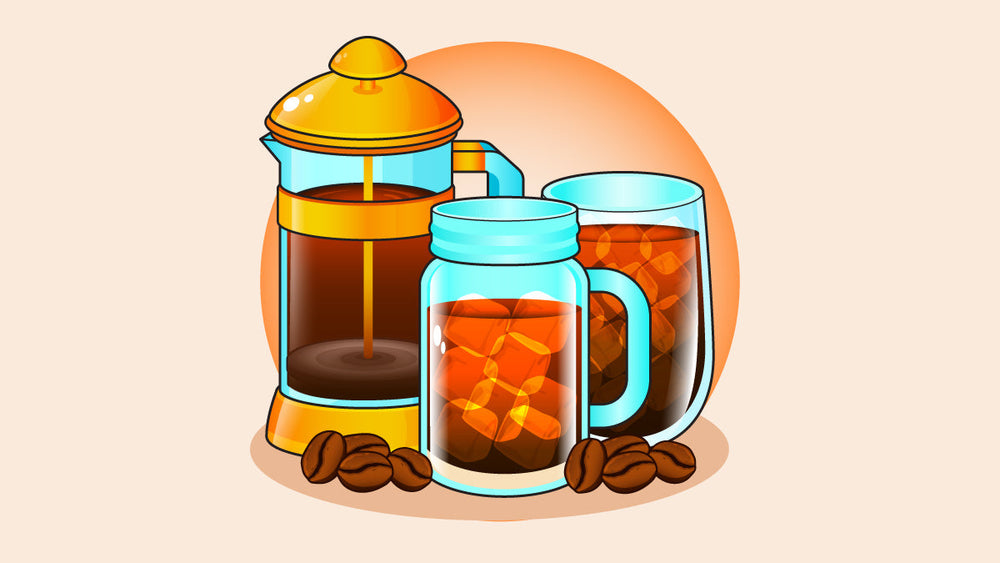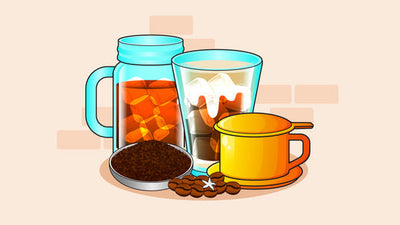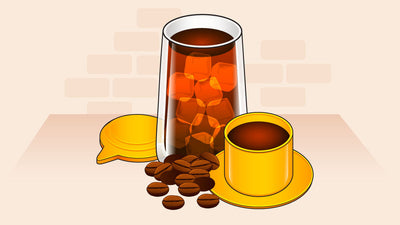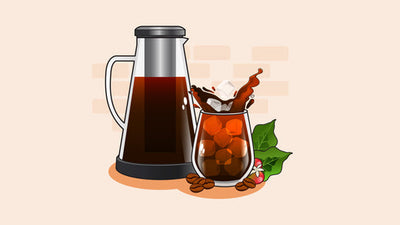Cold brew coffee is celebrated for its smooth, mild flavor and low acidity compared to hot coffee.
This brewing technique involves steeping coarse-ground coffee in cold or lukewarm water for several hours (usually overnight in the fridge). Cold water provides a more gentle extraction of flavors and oils — resulting in a concentrated but smooth coffee with a rich, full-bodied flavor.
Cold brew coffee can be served black or diluted with water or milk.
There are several prominent methods for brewing cold brew coffee at home — each one has their pros and cons.
For this guide, we explore the simplest of these techniques — immersion cold brew.

Cold Brew Specs
- Brew Time: 18–24 hours
- Coffee/Water Ratio: 1:8
- Grind: Coarse
- Water Temperature: 37.4–68ºF (3–20ºC)
- Recommended Coffee: DaLat
Tools You’ll Need
To make cold brew coffee, you’ll need the following items/ingredients:
- A Glass Jar or French Press — The size of your container determines how much coffee you can make. For one person who drinks one coffee per day, a 1-liter French Press or 1-liter jar should provide enough coffee for 3–5 days.
- High-Quality Coffee — Opt for fresh-roasted, whole-bean coffee for the best flavor. Choose a roast profile that suits your taste. For a smooth, balanced flavor, try our DaNang medium roast coffee. For a bolder, richer flavor, try our SaiGon OG instead (perfect for making cold brew Vietnamese coffee).
- A Refrigerator — We like to brew our cold brew in the fridge in bulk and drink it slowly over a few days. Others prepare a fresh cup every night and add ice in the morning to cool. Both methods work great.
- Coffee Grinder — A burr grinder will provide the best grind consistency for cold brew. Blade grinders work, too, but tend to produce more fine particulate that can give the cold brew a chalky texture.
Step-By-Step Instructions: Cold Brew Coffee
Here’s a simple process for making cold brew coffee at home (the easy way).
Note: There are many great dedicated cold-brew devices you can check out online. Most work perfectly fine, but they’re not necessary to brew quality cold-brew at home. A simple mason jar or French press works great.
Related: How To Brew Using French Press?
Step 1: Measure & Grind Your Coffee

The amount of coffee you’ll need will depend on the size of your container (chart below). The ratio you’ll want to aim for is around 8 parts water for every 1 part coffee.
Use a coffee grinder to prepare whole beans, or use a bag of our pre-ground coffee to skip this step entirely.
Cold Brew Coffee Ratios
|
Container Size |
Servings |
Coffee |
Water |
|
3-Cup French Press (12 oz | 350 mL) |
2 servings |
27 grams (5 tablespoons) |
7.5 oz (220 mL) |
|
4-Cup French Press (17 oz | 500 mL) |
4 servings |
45 grams (8–9 tablespoons) |
12 oz (350 mL) |
|
8-Cup French Press (34 oz | 1000 mL) |
8 servings |
80 grams (15–16 tablespoons) |
22 oz (650 mL) |
|
12-Cup French Press (51 oz |1500 mL) |
12 servings |
125 grams (23–25 tablespoons) |
34 oz (1000 mL) |
Step 2: Combine Coffee & Water

Cold brewing couldn’t be simpler. Mix your coffee and water together in your French Press or mason jar, give it a stir, and attach the lid.
Slowly stir the coffee and water together a few times, then, place the whole thing in your fridge.
Step 3: Let it Steep for 24 Hours

It takes a long time to brew coffee with cold water. As the water temperature goes down, so does it’s capacity to pull the desired flavor compounds out of your coffee.
Let your coffee sit for around 18 to 24 hours before taking it out of the fridge. You don't need to worry about stirring your coffee during this time; just let it sit.
Step 4: Strain to Remove the Grounds

After 18 to 24 hours, you can remove your coffee from the fridge and use the plunger on your French press to push all the grounds to the bottom. Pour your coffee into a fresh, resealable container.
If you used a jar to brew your coffee, you’ll need to filter it when it’s done. A fine strainer, some cheesecloth, or a muslin bag all do the trick. Filter the coffee grounds from the water and store it in a fresh container.
Step 5: Serve & Sweeten

Your coffee is not ready to drink! Pour yourself a cup, add some ice, milk, cream, or more water — there’s no right way to do it, so play around with different recipes and flavors until you find something that works for you. You can even take things a step further by infusing your cold brew with nitrogen, creating a smooth and creamy nitro coffee at home.
Try starting with around 3/4 cup of cold brew coffee (180 mL) into a cup filled with ice and 2 ounces (60 mL) of milk or cream to sweeten. Oat milk, coconut cream, and soy milk are all great alternatives to mix with cold brew coffee.
Expert Tips & Tricks: Cold Brew Coffee
There’s no reason to overcomplicate the cold brew process: cold water + coarse-ground coffee + time = delicious cold brew coffee.
However, there are a few tips and tricks you can follow to get the best-tasting coffee possible.
1. Cold Water is Essential
Avoid using hot water to brew your cold brew, even if you plan to still put it in the fridge. Hot water has a higher solubility and will over-extract your coffee if left too long. Cold or room-temperature water will facilitate a slower extraction.
2. Get Creative With The Flavors
You can infuse your cold brew with all kinds of flavors — cinnamon, cardamon, vanilla, and chocolate — which are all great additions to your steep to create new, personalized flavors. Syrups, herbs, and spices are also excellent post-steep additions to spruce up your brew.
3. Store in an Airtight Container
After the brew has finished steeping, you can store it in the fridge for up to a week — but only if it’s kept in an airtight container like a jar or bottle. Exposure to air will cause your coffee to develop off flavors in just 2-3 days.
History of Cold Brew Coffee
The true origins of cold brew coffee is unknown, but it dates back centuries. There’s evidence of cold-steeped coffee in various cultures around the world, including Japan, Latin America, and Africa.
The popularity of this chilled coffee beverage spiked in the United States in the 1960s and has since become a summer staple in cafes and homes all over the country.
Its smooth, mild profile and low acidity make it an ideal source of coffee for those who find conventional brews upset their stomach. It’s also a much more refreshing alternative to conventional coffee in the hot summer months.
FAQs: Cold Brew Coffee

1. What makes cold brew coffee different from regular coffee?
Cold brewing uses cold water to extract the active elements in coffee. Cold water is a less efficient solvent than boiling water, so it extracts fewer of the heavier, more bitter, or acidic elements. The catch is that it also takes much longer to prepare. Cold brew coffee takes about 18–24 hours to make but produces a deliciously sweet and aromatic coffee.
2. What is the best grind for making cold brew?
Most experts recommend using coarse-ground coffee to make cold brew, but some users go as fine as medium-grind. The finer you go, the more sediment you’ll get in the finished cold brew.
3. How long should cold brew coffee steep?
We recommend steeping your cold brew for at least 18 hours. The ideal time is about 24 hours, and the maximum should not exceed 36 hours.
The longer you let your cold brew steep, the stronger it will taste.
3. What is the ideal coffee-to-water ratio for making cold brew coffee?
We recommend starting with a coffee-to-water ratio of 1:8. For a stronger brew, go down to 1:6. For a lighter, brighter cup, bump the ratio to 1:10.
4. Can cold brew coffee be made without special equipment?
You bet! All you need is a jar and some way of straining your coffee (mesh filter, muslin cloth, cheesecloth, or other fine strainer all work), or a French press.
If you're making a lot of cold brew, you can opt for a dedicated cold brew device with a built-in filter.
5. How should cold brew coffee be stored, and how long does it last?
Cold brew will keep fresh for up to a week if stored in an airtight container in the fridge. Make sure your brew is sealed to avoid contamination with mold or bacteria.
6. What’s the best coffee to use for making cold brew?
Any coarse-ground coffee can be the best coffee to make cold brew — however, most experts agree that medium or medium-dark roast arabica beans produce the best flavor overall. Try our delicious DaLat arabica coffee for a smooth, low acid cup.
If mixing your cold brew coffee with condensed milk to make iced Vietnamese cold brew coffee, we recommend using a 50/50 arabica/robusta blend, such as our DaNang coffee.


















